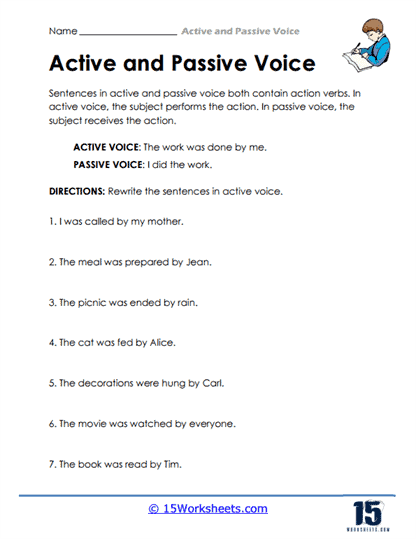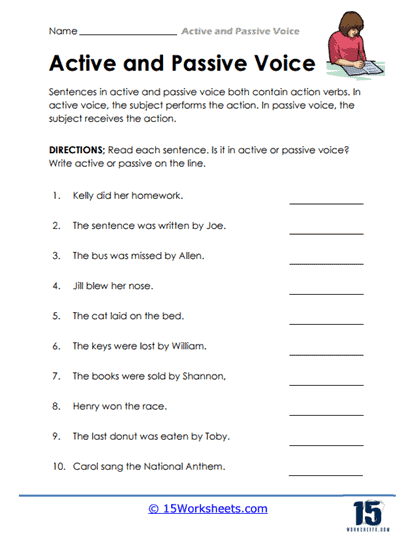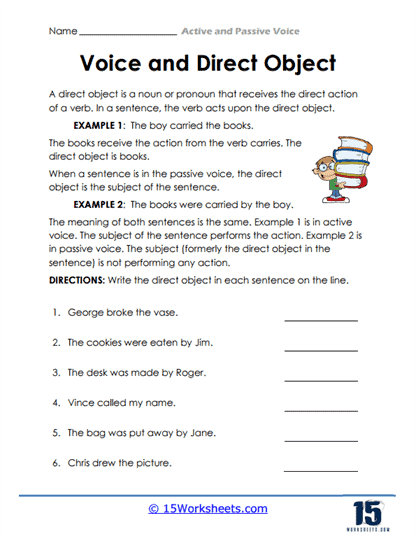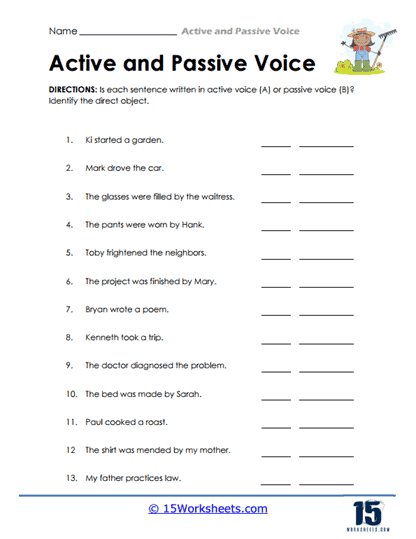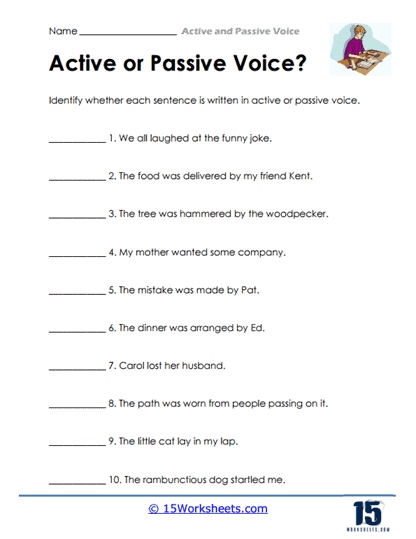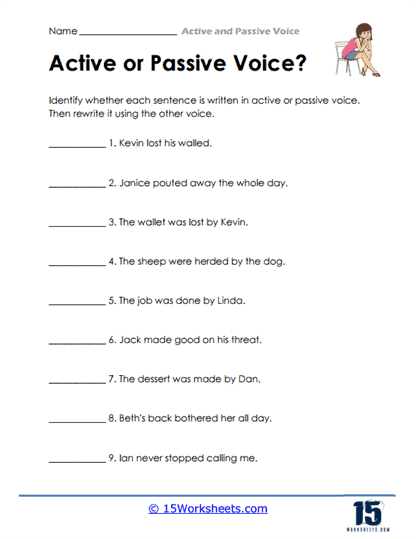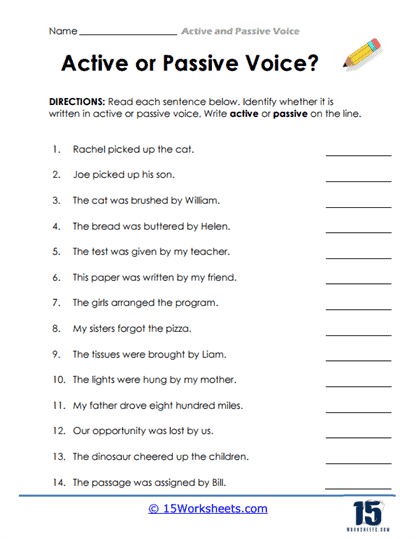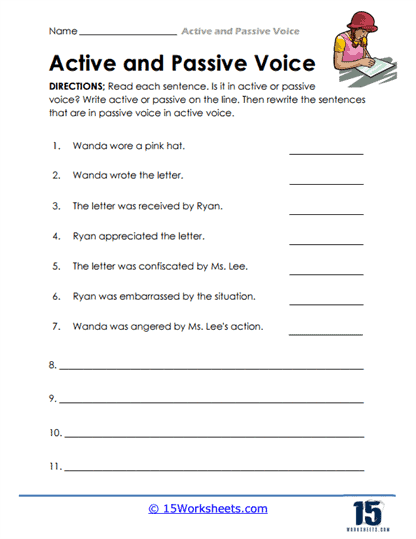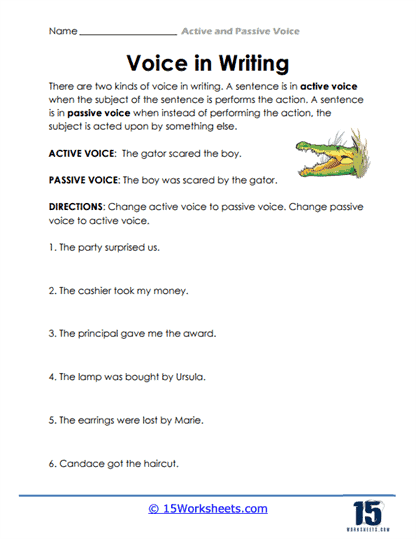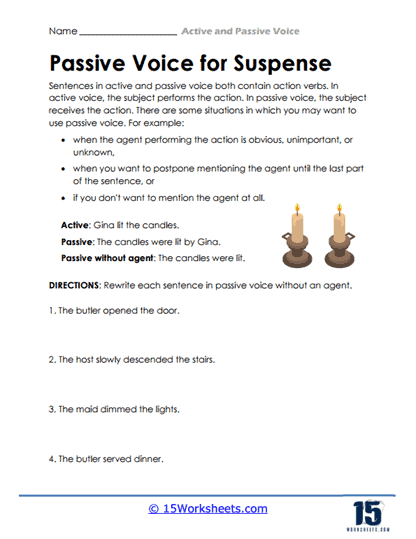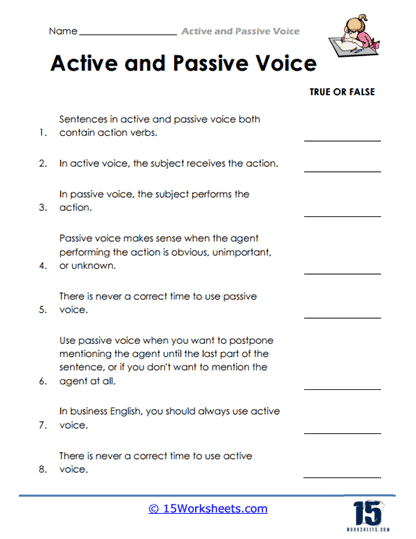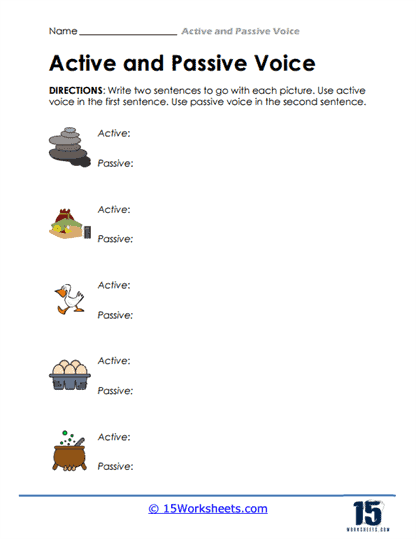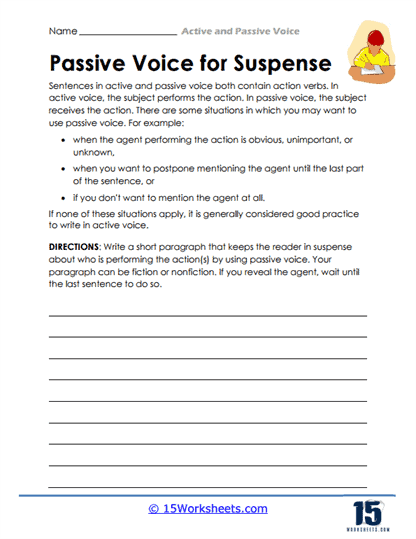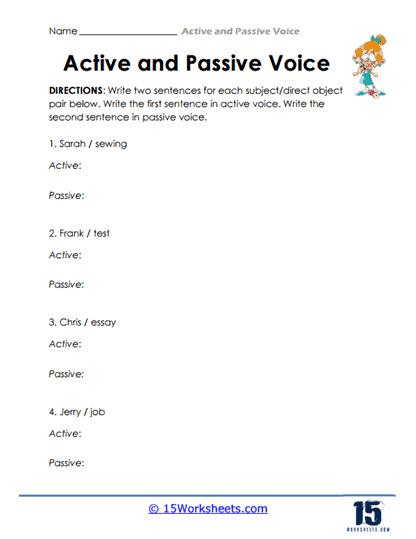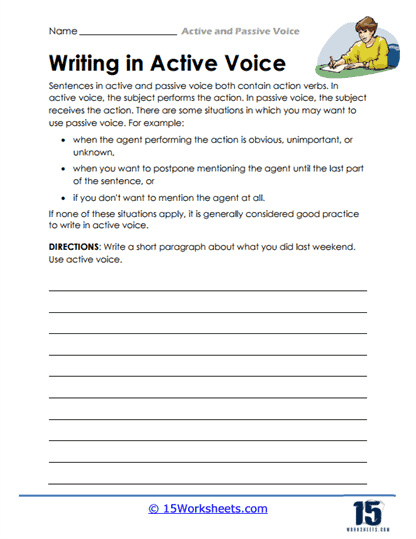Active and Passive Voice Worksheets
All About These 15 Worksheets
Students delve into the realm of active and passive voice writing with this series of 15 worksheets, designed to help them understand and utilize active and passive voice effectively in their writing. Each worksheet in this series provides students with a systematic approach to grasp the nuances of voice usage, enabling them to enhance their writing clarity, style, and precision.
This series caters to students across different grade levels and language proficiency levels, offering a range of worksheets that cover various aspects of active and passive voice writing. Through these writing exercises, students develop the skills necessary to confidently employ both voices in their written work. By completing these worksheets, students will:
- Rewrite sentences to transform those writen into active voice into passive, and vice versa;
- Determine if sentences are in the active or passive voice;
- Identify the direct objects in sentences;
- Write their own sentences in active and passive voice;
- And learn to recognize situations where active voice is preferred for its directness and impact, and where passive voice can provide a shift in tone or emphasis.
Overall, this series of worksheets serves as an invaluable resource for teachers seeking to guide their students in effectively utilizing active and passive voice in their writing. By engaging with these worksheets, students gain the necessary knowledge and practice to master voice manipulation, enabling them to craft impactful and polished written work across various genres and subjects.
Active and Passive Voice Writing
The difference between writing in active and passive voices lies in the way the action in a sentence is presented and how the subject and object are related. Both voices can be used in writing, but they have different effects on the clarity and style of the text.
Active Voice
In active voice, the subject of the sentence performs the action. The focus is on the doer of the action, making the sentence more direct and clear. Active voice is generally preferred in writing because it is more concise and easier to understand. It is also considered more engaging and dynamic.
- Example: The dog (subject) chased (verb) the cat (object).
Passive Voice
In passive voice, the subject of the sentence is acted upon by the verb. The focus shifts from the doer of the action to the receiver of the action. Passive voice can sometimes result in sentences that are less clear or more wordy, but it can be useful in certain situations, such as when the doer of the action is unknown, unimportant, or deliberately being omitted.
- Example: The cat (subject) was chased (verb) by the dog (agent).
In general, it is a good practice to use active voice whenever possible to make your writing more clear, concise, and engaging. However, there are situations where passive voice is appropriate or necessary, so it is essential to understand both and use them effectively.
Improving your ability to write in the active voice involves developing a better understanding of sentence structure and practicing the skill until it becomes second nature. Here are some tips to help you improve your ability to write in active voice:
Understand the difference between active and passive voices. Familiarize yourself with the distinctions between the two voices, as explained in the previous answer. Knowing the differences will help you recognize when you are using passive voice and make it easier to switch to active voice.
Identify the subject and verb. In each sentence, identify the subject (the doer of the action) and the verb (the action itself). Ensure the subject is performing the action, rather than having the action done to it.
Practice rewriting sentences. Take sentences written in passive voice and practice rewriting them in active voice. This exercise will help you become more comfortable with the process and better recognize passive constructions.
Use strong action verbs. Choose specific and vivid verbs that clearly convey the action taking place. Avoid weak or generic verbs, such as “is,” “are,” “was,” or “were,” which can often lead to passive constructions.
Minimize the use of “to be” verbs. The verbs “is,” “am,” “are,” “was,” “were,” “be,” “being,” and “been” often signal passive voice when combined with past participles. Try to minimize their use and opt for more active verbs instead.
Be mindful of your writing style. When writing, be conscious of your tendency to use passive voice. Make a deliberate effort to use active voice, and over time, this will become more natural.
Edit and revise. After writing, go through your work and identify any instances of passive voice. Rewrite those sentences in active voice to strengthen your writing.
Read and analyze other texts. Study examples of writing that effectively use active voice. Pay attention to how the authors construct their sentences and convey action. This will help you learn from their techniques and improve your own writing.
Seek feedback. Share your writing with others and ask them to specifically comment on your use of active voice. They may be able to point out instances of passive voice that you missed and offer suggestions for improvement.
Practice regularly. Like any skill, writing in active voice improves with practice. Write regularly and consistently work on incorporating active voice into your writing.
By following these tips and consistently practicing, you will improve your ability to write in active voice, making your writing clearer, more engaging, and more effective.
How to Write in Passive Voice
Although the active voice is generally preferred for clarity and conciseness, there are situations where the passive voice is appropriate or even necessary. To write in the passive voice, follow these steps:
- Identify the subject and object – Determine the subject (the doer of the action) and the object (the receiver of the action) in the sentence. In passive voice, the focus is on the object or the action itself, rather than the subject.
- Reverse the order of the subject and object – In passive voice, the object takes the place of the subject in the sentence. Rearrange the sentence so that the object comes before the verb, and the subject (if included) comes after the verb.
- Use a form of “to be” verb – In passive constructions, a form of the verb “to be” (is, am, are, was, were, be, being, or been) is used in combination with the past participle of the main verb. Choose the appropriate form of “to be” according to the tense and subject of the sentence.
- Add the past participle of the main verb – The main verb in passive voice sentences is in the past participle form (e.g., written, eaten, played). Combine the past participle with the appropriate form of “to be” to create the passive verb phrase.
- Include the agent (optional) – If the doer of the action is relevant or necessary for context, include the agent by adding the preposition “by” followed by the subject. However, in some cases, the agent may be unknown, unimportant, or intentionally omitted, in which case you can leave it out.
Here’s an example to illustrate the process:
Active voice: The scientist (subject) conducted (verb) the experiment (object).
Passive voice: The experiment (subject) was conducted (verb) by the scientist (agent).
Remember that while it’s important to know how to write in passive voice, it’s generally best to use active voice in your writing for clarity and engagement, unless a specific situation calls for passive voice.
Situations where passive voice may be appropriate include:
- When the doer of the action is unknown or unimportant: “The cave paintings were discovered in 1940.”
- When the focus is on the action or the receiver of the action: “A new method has been developed to improve battery life.”
- When the agent needs to be deliberately omitted or de-emphasized: “Mistakes were made during the project.”
In scientific or technical writing, where the focus is on the process or results, rather than the researchers: “The samples were analyzed using gas chromatography.” In such cases, using passive voice can be an effective choice to convey the intended meaning.

